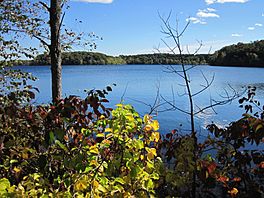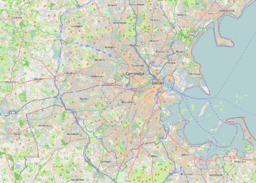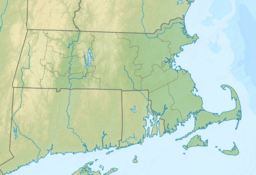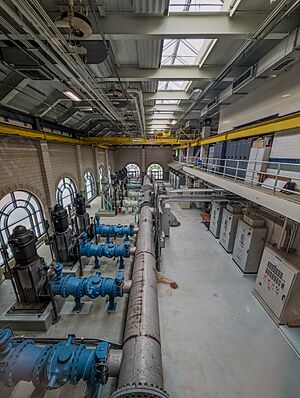Fresh Pond (Cambridge, Massachusetts) facts for kids
Quick facts for kids Fresh Pond |
|
|---|---|

Fresh Pond in October 2010
|
|

General plan for Fresh Pond Park, by the Olmsted Brothers landscape design firm (1897). "[A]lmost none of the plans to relocate the carriage drive [to the route shown] were ever implemented."
|
|
| Location | Cambridge, Massachusetts |
| Coordinates | 42°23′N 71°9′W / 42.383°N 71.150°W |
| Type | reservoir |
| Basin countries | United States |
| Surface area | 155 acres (63 ha) |
| Surface elevation | 3 ft 3 in (1 m) |
Fresh Pond is a very important place in Cambridge, Massachusetts. It is a large reservoir, which means it holds drinking water for the city. But it's also a beautiful park where people love to visit!
Long ago, before it became a reservoir, people harvested ice from the pond. This ice was shipped to many places around the world. Today, Fresh Pond is surrounded by streets like Fresh Pond Parkway and Concord Avenue.
The Fresh Pond Reservation includes the 155-acre lake itself. It also has 162 acres of land around it. There's a 2.25-mile road around the pond. This road is very popular for walking, running, and biking. You can also find a nine-hole golf course here. A special path called the Watertown–Cambridge Greenway runs along the pond's east side.
Early History of Fresh Pond
For thousands of years, Native Americans used Fresh Pond. They fished in its waters and drank from it. In the 1600s, colonists started fishing for alewives in Alewife Brook. This brook passed through swamps north of Fresh Pond. The colonists used the same fishing methods as the Native Americans.
The fields around Fresh Pond were used for growing hay. People also hunted ducks in the pond. In the 1700s, settlers started farms near the pond. In 1796, Jacob Wyeth built the Fresh Pond Hotel. This hotel was on the east side of the pond. Later, a wealthy person built a large estate north of the pond. In the early 1800s, clay was taken from the swamps around Fresh Pond. This clay was used to make bricks.
Water and Ice at Fresh Pond
In the mid-1800s, Fresh Pond was owned by private companies. It was a busy center for the ice-harvesting industry. Ice from Fresh Pond was sent to places as far away as Europe, China, and India. People started cutting ice from the pond in the 1820s.
A railroad was built to connect the icehouses at Fresh Pond to wharves in Charlestown. Famous ice harvesters like Frederic Tudor used this railroad. The first ice shipment by rail happened in December 1841. This railroad later became part of the Fitchburg Railroad.
In 1856, a private company began providing drinking water from the pond. By 1865, the city of Cambridge owned this water business. By the end of the 1800s, the city owned all of Fresh Pond. They also owned the land around it. An advanced system was created to supply public drinking water.
Fresh Pond is an important part of Cambridge's water system. Water flows into the pond from other reservoirs. These are the Hobbs Brook and Stony Brook Reservoirs. They are located in towns like Lexington and Lincoln.
After the water reaches Fresh Pond, it goes to a special cleaning facility. This is called the Walter J. Sullivan Water Treatment Facility. It's right next to Fresh Pond. After being cleaned, the water is pumped to an underground reservoir. This is the Payson Park Reservoir in Belmont. From there, gravity helps the water flow back to Cambridge. This provides clean drinking water to homes and businesses.






